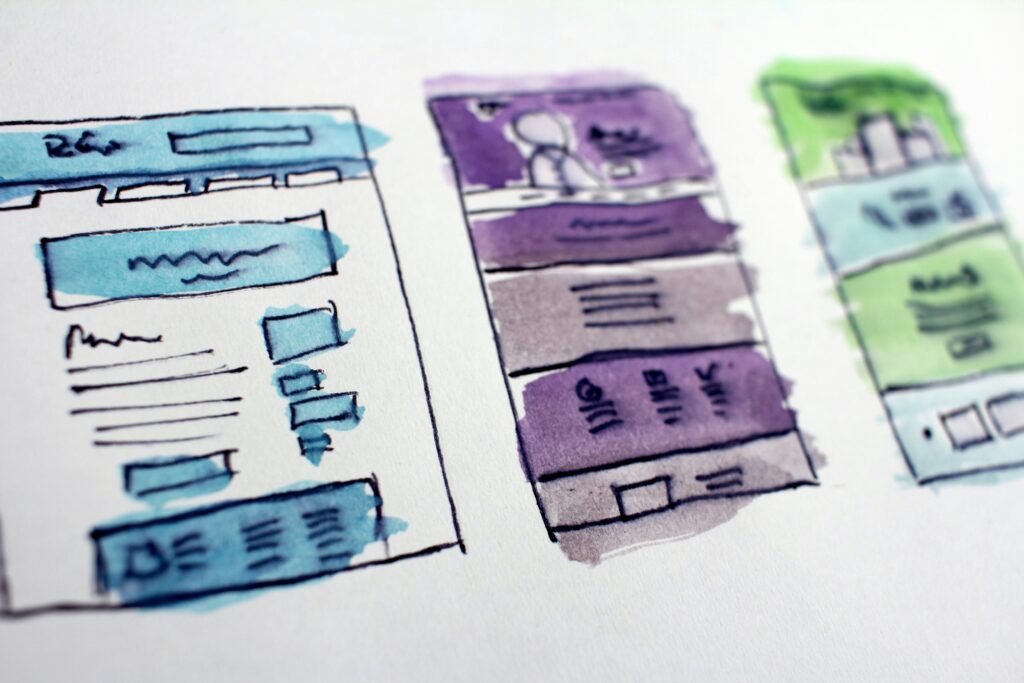Understanding Product Development
Hey there, CEOs, owners, and marketing gurus! Figuring out the nuts and bolts of product development can be your secret weapon. Nail it, and you might just ace that competitive market game.
Six-Stage Product Plan
Alright, here’s the deal – a simple six-step plan to take your product from daydream to store shelves. This roadmap not only organizes your chaos but also gets your peeps from different departments working like a well-oiled machine. Here’s your playbook:
- Spot Market Needs: Find those gaps where your product can shine.
- Scout the Competition: Check out what’s out there and what they’re doing well.
- Dream Up a Fix: Put your thinking cap on for solutions that hit the mark.
- Chart Your Course: Set dates and goals like the captain of a ship.
- Work on an MVP: Craft a bare-bones version to test with real folks.
- Hit the Market: Throw open the doors to customers!
This step-by-step plan keeps your team on track, chasing shared dreams. Craving more details? Hop over to our piece on product development stages.
Teaming Up with Stakeholders
Your product’s fate rests in the hands of those involved in teaming up with stakeholders. Think of them as your Avengers squad: product managers, project leads, creative hands, coders, marketing wizards, sales champs, and top execs (Asana). Each brings their A-game to ensure your product doesn’t just exist, it thrives!
Product managers, for starters, plot the strategic path, crafting visions and building an MVP that fits like a glove for the customer. They keep an eye on the market dance, tweak the product pitch, and monitor every move for changes and chances.
And then, there are tools like Jira to keep everyone in the loop, reducing the classic pitfalls of crossed wires and messed-up resources. Aligning the whole crew into a single force can make or break your milestones. Check out our advice on product roadmaps and snazzy tricks to master the art of collaboration.
Key Factors in Product Development
Figuring out what drives product development success is like finding the secret sauce. Get it right and your product might just be the next big thing that people can’t wait to get their hands on.
Market Identification
Before whipping up your genius product, you gotta know who you’re making it for. Like, who’s your audience? Are they hipsters, techies, or soccer moms? You can sort this out by slapping together some surveys, poring over what your current customers are up to, or even spelunking through what’s trending in your industry.
Here’s the lowdown on what to peek at:
| Component | Description |
|---|---|
| Target Demographics | Know the age, Gander, cash flow, and zip code of your crowd. |
| Market Needs | Spot the gaps and check how your marvelous widget can fill them. |
| Competitor Analysis | Scope out what others are selling and where they’re sitting in the pecking order. |
Poking around market research for product development is a neat trick to suss out your tribe’s gripes and tweak your creation’s charm to fit.
SWOT Analysis
Ever heard of a SWOT analysis? It’s not as swanky as it sounds, but it’s a game changer. It’s your chance to peek around the corner at your product’s Strengths, Weaknesses, Opportunities, and Threats—all those little goodies that can make or break the whole gig.
| SWOT Component | Description |
|---|---|
| Strengths | The shiny stuff you’ve got going for you (think: rad features or killer tech). |
| Weaknesses | The hurdles you might trip over (like being broke or clueless). |
| Opportunities | The new horizons to chase (catching the latest fads or surfing the tech wave). |
| Threats | The nasty surprises that could rain on your parade (pesky rivals or law changes). |
Mapping out a SWOT gives you a crystal ball—or at least a GPS—into where your thingamajig fits in. Smart moves hinge on this kind of insight and crafty ploys drawn up with new product development strategies.
Remember, a solid roadmap, stirred with market sense and SWOT wisdom, is your North Star to real results. To keep your fingers on the pulse, peep into a product development roadmap which keeps tabs on key performance moments (KPIs) and maps out what steps groove with your ultimate mission.
The Prototyping Stage
The prototyping stage is a make-or-break part of building a product. You need a game plan and some smart moves to get it right. At this point, you’re diving into two big areas: figuring out if this thing can actually work (feasibility analysis) and whipping up a bare-bones version of your product, also known as a minimum viable product (MVP). These steps help you see if your idea is solid and if people will actually want what you’re offering.
Feasibility Analysis
You don’t want to pour time and money into a dud, right? That’s where a feasibility analysis comes in handy. You’ve got to check if your idea is something you can pull off and if it’s even worth the hassle. It means looking at how this idea stands when it comes to tech stuff, money, and whether you have what it takes to keep the gears running. Having all this info helps you dodge potential pitfalls before they trip you up.
Components involved in checking feasibility:
| Component | What It’s About |
|---|---|
| Technical Stuff | Do you have the tech and tools to pull this off? |
| Money Matters | How much is it gonna cost you, and will the revenue be worth it? |
| Getting It Done | Do you have the processes and crew to make it happen? |
| Market Check | Are people out there looking for what you’re planning to offer? |
Don’t forget to do some market risk snooping, checking out the competition and any curveballs the market might throw your way.
Minimum Viable Product (MVP)
Now, the MVP is your chance to take your idea to the field with just the essentials. You just need the key features that will get early users on board to start giving you feedback. It’s all about seeing if your assumptions hold water and if your product fits the bill.
Reasons why an MVP is a good move:
| Reason | Why It Rocks |
|---|---|
| Wallet-Friendly | Cuts down on time and resources early on. |
| Quick Reactions | Get instant thoughts from users to shape your next steps. |
| Less Risk | Helps avoid launching a flop that the market doesn’t want. |
| Zeroes In | Keeps you focused on what really matters for your users. |
The MVP is like your product’s test run, letting you tweak and tune based on what users actually do with it. Picking the right features for your MVP is a big deal—just enough to keep users engaged and eager to tell you what they think. Want to get better at rolling out products? Check out our piece on new product development strategies.
During prototyping, you’re laying down the groundwork for turning your idea into reality. By carefully examining feasibility and smartly crafting your MVP, you’re setting the stage for smashing success in the marketplace. Remember, every move you make now edges you closer to a polished product and a smoother ride to getting it out there. Curious about the whole product development life cycle? We’ve got more resources for you to explore.
Commercializing the Product
Turning your product into a market favorite isn’t just about having something cool to sell—it’s about how you unleash it to the world and figure out what’s making it tick along the way. Pay attention to the game plan and the numbers, and you’re on your way to success.
Launch Strategy
If you want folks to notice your product, you’ve got to know your game. Here’s the playbook filled with some must-dos:
Target Audience: Figure out who gets the most outta your product. Your customer personas are your guide to crafting messages that hit the mark.
Marketing Channels: Pick the right platforms to shout about your product. Whether it’s lighting up social media, sending those emails, or dropping ads in the right places.
Promotional Activities: Think up deals that get people grabbing their wallets. A special price tag might just create the buzz you need.
Implementation Timeline: Map out a schedule to keep your launch on track. A little organization goes a long way in getting things done when they matter most.
| Launch Strategy Components | Details |
|---|---|
| Target Audience | Who’s buying and why |
| Marketing Channels | Get social, send emails, place ads |
| Promotional Activities | Deals and steals |
| Implementation Timeline | Timing is everything |
If you’re itching for more pro tips on launching, check out our thoughts on product launch strategy.
Performance Metrics
Once the product is out in the world, pull out your magnifying glass and start looking at the numbers that matter. These help see if what you got is gold—or needs a little polish. Key indicators to keep an eye on include:
Sales Volume: Count what you’re selling over time. This shows if people are digging it or if it’s collecting dust.
Customer Acquisition Cost (CAC): Know how much it costs you to win over a new customer. Keeping these costs down helps keep your pocket full.
Customer Satisfaction Score (CSAT): Chat with your customers to see if they’re smiling or frowning at your product. Their thoughts can be your ticket to making things better.
Retention Rate: Check how many customers keep coming back for more. A high number here often means you’ve hit the nail on the head with what you’re offering.
| Performance Metrics | Measurement Criteria |
|---|---|
| Sales Volume | Units flying off the shelf |
| Customer Acquisition Cost | Bucks spent per new face |
| Customer Satisfaction Score | How happy they are |
| Retention Rate | Loyalty factor |
Playing close attention to these will help you make smart moves for future product tweaks and get your marketing engine purring smoothly. For more on keeping track of these metrics, dive into our piece on product development metrics.
Marrying a sharp launch approach with killer numbers is your ticket to nailing product commercialization. This way, not only do you make a splash in the market, but you keep swimming strong with feedback-driven improvements.
Project Milestones Importance
Getting a handle on your product development project hinges on knowing just how important milestones are to your success. Every milestone marks a point on the map of your project’s life cycle, helping you see how far you’ve come and figure out what hurdles might lay ahead.
Tracking Progress
Milestones are like road signs that guide you through your project. By breaking up the timeline, they let you keep tabs on the important bits and see what’s been ticked off the list. This organized setup helps keep the project train rolling smoothly, ensuring you don’t run outta steam. Plus, milestones nail down the all-important dates and happenings in your plan, making sure everything’s timed just right for a seamless execution (ProjectManager).
Visualizing your milestones gives you a snapshot of where things stand and what’s left on the to-do list. Regular check-ins can catch potential bumps and give you a chance to tweak your game plan as needed.
| Milestone | Purpose |
|---|---|
| Initial Design Completed | Review and Feedback |
| Prototype Developed | User Testing |
| Project Launch Date Established | Marketing Prep |
These checkpoints make sure your team stays accountable. When you assign folks to watch over specific milestones, it’s like giving everyone a piece of the pie to own, keeping all eyes on the prize.
Mitigating Risks
Building milestones into your project plan is a smart move for keeping trouble at bay. By pinpointing clear moments for reflection, you can catch snags before they turn into a full-blown mess. Being prepared like this means you can tackle issues head-on before they turn into a mountain of problems.
Frequent milestone check-ups keep communication open with all the people involved, so everyone’s clued in on how things are going and on any hiccups that might pop up. You can use strategies like the critical path method (CPM) to stay on track and dodge any skids off schedule (ProjectManager).
Milestones don’t just serve as guideposts; they’re also cause for celebration. Recognizing achievements along the way keeps spirits high, building stronger connections and dedication to the project. This kind of acknowledgment is key to keeping the team pumped and can lead to even better work.
For more insights on mapping out your product development, dive into our pieces on the product development life cycle and product development roadmap.
Essential Milestones in Software Development
In the world of software development, hitting important milestones can make or break your project. Two big ones are user testing and deployment. Let’s jump into what makes each of these steps so critical.
User Testing
User testing, otherwise known as user acceptance testing (UAT), is the show before the big show. In this phase, you get to see if everything you’ve built matches what people actually want. Real-life users take your software for a test drive and give you their two cents on how it rolls and where it hits the bumps.
Clear criteria for success during this stage are important. Here’s a simple chart to keep track of the key aspects in user testing:
| Metric | Description |
|---|---|
| Test Cases Completed | How many scenarios did we run through? |
| Bugs Found | Count of the pesky issues |
| User Feedback Score | Average thumbs-up from satisfied users |
| Requirements Met Percentage | How many needs did we hit correctly? |
By keeping an eye on these, you make sure the software is ready for showtime and aligns with both user satisfaction and business goals. Curious about making your development framework more robust? Check out our guide on product development in marketing.
Deployment
Deployment is where the action happens. It’s the step that takes your app from a creation in progress to a live product. Here, you set up the production habitat, launch the application, and cross-check that it runs smoothly before throwing open the doors.
Nailing your deployment strategy is crucial to getting things off without a hiccup. Here are some things to ponder:
| Deployment Aspect | Key Points |
|---|---|
| Hosting Environment | Is it safe and ready to grow? |
| Application Testing | Have we hammered out all the kinks before go-time? |
| Performance Metrics | What are the standards for measuring success once it’s live? |
Having a detailed plan for deployment cuts down on troubles that might spring up after launching. For tips on really nailing your launch, take a peek at our product launch strategy.
Zeroing in on user testing and deployment in your software development process sets your product up for success. Using a thoughtful approach lets you keep tabs on progress and nip any problems in the bud, making sure your product shines.
Product Development Metrics & KPIs
Getting a handle on the right numbers can make or break your product’s growth story. When you know what to look at, you can craft strategies that push things forward. Two big hitters on the metric scoreboard are Average Revenue per User (ARPU) and Net Promoter Score (NPS). They’ll give you the lowdown on how well your product’s performing and your customers’ satisfaction levels.
Average Revenue per User (ARPU)
Think of Average Revenue per User (ARPU) like your product’s financial report card. It’s your go-to metric for figuring out the cash you’re pulling in from each customer over a set time. Think subscription fees, one-time buys, upsells, and any ad revenue (AltexSoft). Calculating ARPU shines a light on your product’s money-making mojo, helping you nail those pricing strategies.
Here’s the ARPU breakdown:
[ \text{ARPU} = \frac{\text{Total Revenue}}{\text{Number of Users}} ]
| Time Period | Total Revenue | Number of Users | ARPU |
|---|---|---|---|
| Monthly | $50,000 | 1,000 | $50 |
| Quarterly | $150,000 | 3,000 | $50 |
| Annually | $600,000 | 10,000 | $60 |
Pair ARPU with other key figures like Customer Lifetime Value (CLTV) and Customer Acquisition Cost (CAC). This combo helps you see if what you’re spending to acquire customers makes sense given the revenue you get from them. It’ll sharpen your strategies for marketing and sales.
Net Promoter Score (NPS)
Net Promoter Score (NPS) is all about customer loyalty and satisfaction. It measures how much your customers like you, asking them if they’re willing to shout out your product to buddies. They get sorted into promoters, passives, or detractors (AltexSoft). Knowing your NPS can drive how you spruce up user experiences, fix what’s broke, and boost growth.
The NPS calculation stems from asking one simple question: “On a scale from 0 to 10, how much do you want to recommend our product to a friend or colleague?”
| Score Range | Category |
|---|---|
| 9-10 | Promoters |
| 7-8 | Passives |
| 0-6 | Detractors |
To find your NPS, take the percentage of promoters and subtract the percentage of detractors:
[ \text{NPS} = \% \text{Promoters} – \% \text{Detractors} ]
| NPS Calculation | Promoters (%) | Detractors (%) | NPS |
|---|---|---|---|
| Example 1 | 70% | 20% | 50 |
| Example 2 | 40% | 30% | 10 |
NPS shows you where you can step up your game and reveals what’s already hitting the mark. Keep tabs on NPS to see if the tweaks you make in your strategy are paying off.
For more nuggets on product development metrics and to line up your blueprint, check out the links peppered throughout this piece. These metrics are your milestones on the road to product success, steering you towards choices that hit home with your fans.
Setting Realistic Business Milestones
Laying down realistic milestones for your business is key to steering your product’s path. Keeping an eye on progress and staying flexible will help you manage the bumpy ride to launching your product.
Progress Monitoring
Keeping tabs on your progress is like having a map—it keeps you moving in the right direction. Setting clear milestones gives you checkpoints to assess how things are going. By having a well-laid plan, you can stay on top of what’s happening and make sure you’re on track for those big goals (WatchMyCompetitor).
Here are some handy ways to keep an eye on progress:
| Metric | What It Tells You |
|---|---|
| Completion Percentage | The amount of work done compared to what you planned. |
| Budget Utilization | How much money you’ve spent against what you planned to spend. |
| Time Lag | How your actual timeline measures up to your planned schedule. |
Keeping your team and stakeholders in the loop with these milestones helps everyone stay on the same page. Tools out there, like Wrike, let you assign folks to different tasks so everyone’s clear on what’s going down and who’s doing what (Wrike).
Adaptability Strategies
Being able to roll with the punches is super important in product development. Flexibility lets you tackle surprises and make the most out of new chances. One way to stay nimble is by using iterative development cycles—constantly tweaking your product based on feedback to get better results over time (WatchMyCompetitor).
Planning for risks is also a smart move. By spotting potential hiccups and having backup plans, you can keep moving forward, even if things get tricky. Tools that help teams work across departments ensure everyone’s heading toward the same goals and knows the latest progress.
In the end, keeping an eye on your progress and being ready to change course are must-dos for setting realistic business milestones. Focusing on what you can measure and staying adaptable throughout the process will boost your chances of success. For more tips, check out our articles on product development metrics and product launch strategy.





















